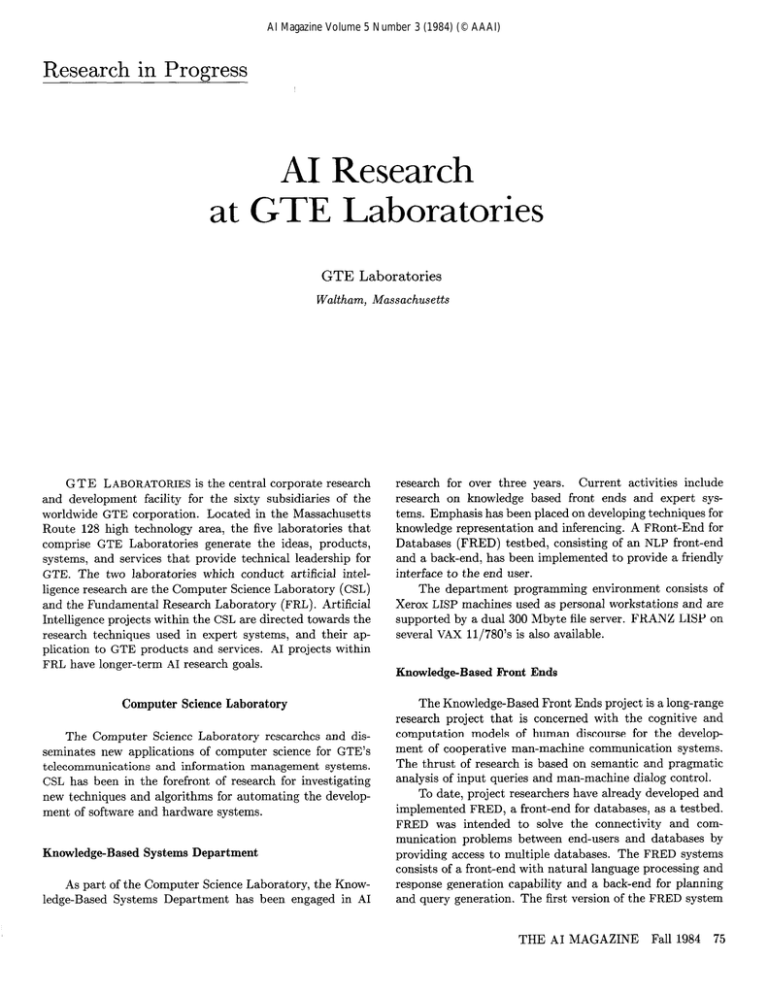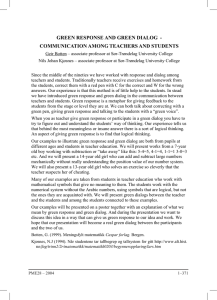AI Research at GTE Laboratories GTE Laboratories
advertisement

AI Magazine Volume 5 Number 3 (1984) (© AAAI) Research in Progress AI Research at GTE Laboratories GTE Laboratories Waltham, Massachusetts GTE LABORATORIES is the central corporate research and development facility for the sixty subsidiaries of the worldwide GTE corporation. Located in the Massachusetts Route 128 high technology area, the five laboratories that comprise GTE Laboratories generate the ideas, products, systems, and services that provide technical leadership for GTE. The two laboratories which conduct artificial intelligence research are the Computer Science Laboratory (CSL) and the Fundamental Research Laboratory (FRL). Artificial Intelligence projects within the CSL are directed towards the research techniques used in expert systems, and their application to GTE products and services. AI projects within FRL have longer-term AI research goals. Computer Science Laboratory The Computer Science Laboratory researches and disseminates new applications of computer science for GTE’s telecommunications and information management systems. CSL has been in the forefront of research for investigating new techniques and algorithms for automating the development of software and hardware systems. Knowledge-Based Systems Department As part of the Computer Science Laboratory, the Knowledge-Based Systems Department has been engaged in AI research for over three years. Current activities include research on knowledge based front ends and expert systems. Emphasis has been placed on developing techniques for knowledge representation and inferencing. A FRont-End for Databases (FRED) testbed, consisting of an NLP front-end and a back-end, has been implemented to provide a friendly interface to the end user. The department programming environment consists of Xerox LISP machines used as personal workstations and are supported by a dual 300 Mbyte file server. FRANZ LISP on several VAX 11/780’s is also available. Knowledge-Based Front Ends The Knowledge-Based Front Ends project is a long-range research project that is concerned with the cognitive and computation models of human discourse for the development of cooperative man-machine communication systems. The thrust of research is based on semantic and pragmatic analysis of input queries and man-machine dialog control. To date, project researchers have already developed and implemented FRED, a front-end for databases, as a testbed. FRED was intended to solve the connectivity and communication problems between end-users and databases by providing access to multiple databases. The FRED systems consists of a front-end with natural language processing and response generation capability and a back-end for planning and query generation. The first version of the FRED system THE AI MAGAZINE Fall 1984 75 was implemented in INTERLISP 370 on an IBM mainframe and was tested in the domain of relational databases for handling table formatted data. The current version of the FRED testbed is implemented on Xerox LISP machines, and provides access to several medical databases. Long-range research in this program is based on studying cognitive and computational models of discourse, developing formal foundations for cooperative man-machine dialog and integrating an intelligent user interface that includes natural language processing, dialog control and logical inferencing capabilities. Two potential application areas are communication with expert systems and accessing information from multiple databases. Cooperative Man-Machine Dialog Research on conceptual foundations of a cooperative man-machine dialog is based on a broad scope of issues. These issues include the status and dynamic structures of a dialog, and analysis of domain-oriented patterns of a dialog, the theory of direct and indirect questions and responses, the incorporation of user models (level of experience, intention, beliefs, etc.), the shaping of the mode of the dialog, the support of the context-keeping and focus-shifting of the dialog, the provision for instructive help and explanation facilities, and the availability of dialog correction and recovery mechanisms. Natural Language Processing To date, “Interaction Scenarios,” a computational formalism for adjusting and shaping the interactive dialog with an expert system has been developed. The model of a “dialog engine,” a mechanism fo conducting dialogs with multiple dialog control strategies, is under investigation. Research on natural language analysis supports our efforts in building cooperative dialog systems. Present emphasis includes the following issues: spelling corrections; processing ill-formatted inputs; and processing elliptical and anaphoric expressions. Research also covers activity on new meaning representation models which integrate the declarative power of frames and procedural mechanisms of production rules. Research on natural language generation concentrates on the problem of text generation in relation to the context of the current stage of the dialog. These studies include issues such as knowledge representation and equivalent transformation for generation, resolving references, morphological refinements, text shaping based on user’s inputs, and generating elliptical and indirect responses. Cooperative Independent Reasoning. It has become increasingly clear from the experiences reported by various researchers, that individual expert systems need to pool their resources in order to solve more complicating problems. This pooling, however, introduces a separate set of problems. For example, envision two expert systems, INTERNIST and PUFF, consulting with each other to diagnose a particularly complicating case. In order to do this, each of the systems must have a strategy on how to solicit aid from external sources, a knowledge base on what information other experts possess, and methods of resolving any conflicts in the knowledge embedded in the independent systems. The work on cooperative independent reasoning will concentrate on the first of these knowledge issues, namely, a strategy on how to solicit information from external sources. The investigation will begin with a more directed cooperation than presently observed in current “blackboard models” such as the Hearsay system. Perhaps a variation of the message passing paradigms in Actors or in the object-oriented approaches will be used. The first concrete activity for this effort in 1984 will be to acquire an object-oriented programming system for representing and directly simulating the negotiations of the cooperating experts. Decentralized control would be used in the first method of cooperation studies. Future work may include a more thorough modeling of distributed reasoning; investigating distributed vs centralized inferencing, distributed vs centralized knowledge sources, and data vs goal-directed strategies. Meta-Expert Systems. The overall objectives of this effort are to recognize and formalize the generic features of expert systems and to develop the architecture and functional primitives of an expert system. These formalisms will be used in representing the meta-structure of knowledge in expert systems. A successful meta-expert system should be useful in a number of tasks, for example, maintaining acceptable levels of consistency and utility in an expert system’s knowledge base. Expert System Applications. The expert system application effort will increase our present experience base. The objectives are: to build expert systems to investigate the utility of this technology for use throughout the corporation; and to transfer the expert systems technology to the appropriate sites throughout GTE. The focus of this activity is the development of the technology for building expert systems. Some of the interesting problems include the development of methodologies, tools, or techniques for the following: the selection of expert system domains and tools, expert debriefing, representation of expert knowledge, testing and evaluating expert systems, and rapid prototyping of expert systems. Contact: Shrz Goyial, Department Manager Expert Systems Research Fundamental Research Laboratory Research on expert systems, focuses on three aspects: cooperative independent reasoning, meta-expert systems, and expert system applications. 76 THE AI MAGAZINE Fall 1984 Within Laboratory GTE Laboratories the Fundamental Research seeks advancement of the frontiers of science in order to provide the parent company ultimate technological competitive advantage. The quality of its research is attested to be a strong publications record of more than two papers published in refereed journals per scientist per year. Established activity in physics, chemistry, and biology include projects in organic nonlinear optics, photonics, the membrane biochemistry of vision, and the synthesis of novel macromolecules for use in electronics. To complement work in the traditional physical sciences, a new department has been formed to pursue artificial intelligence research. Information Sciences Department The Information Sciences Department has three research thrusts, distributed intelligence, machine learning, and the application of artificial intelligence to mathematics. Clearly, the first two goals pertain to telecommunications systems of the future. Presently, GTE personnel and products provide service to people through a complex of equipment. We must understand the customer’s needs, expressed in a variety of ways, and as a result, transmit, transform, and generate information. In the future, the equipment will be more sophisticated. (Actually, the limits on just how useful and complex such systems will be are those imposed by our own imagination.) Presuming that the system itself, the service and loads, and the external environment all change over time, there will be no central control. Instead, the system will have to develop a self-awareness as a result of cooperation of its intelligent parts and will have to learn how to manage itself; thus, the need for research into distributed intelligence and machine learning. There are several ways to classify the kinds of changes that machine learning should result in; that is, ways in which running software can improve itself, as judged by its users. Parameters can be altered slightly, with the system interpreting the resulting performance as an improvement or not. However, perhaps there is some non-incremental change available, like the addition of a previously unknown capability, in the form of a constructed subroutine. The useful implementation of this type of learning will require not only the analysis of the domains of application, but also the experimentation in the meta-rules that govern how they should be described and manipulated. Eventually, it would be desirable to evolve such systems by themselves, and to describe their behavior with the suitable formalisms to delineate their capabilities. Taking the examination of mathematics from the AI point of view as one of our key efforts follows from the role of mathematics as a unique tool in providing essential insight and understanding in the pursuit of scientific knowledge in other areas. Although knowledge-based systems have been built to assist the user of mathematics, these were designed to handle specific complicated tasks, thus limiting their value. Little work has been done to evolve such systems from a model of mathematics and the ways in which it is used. Based on the experience of applying mathematics to theory formation in the physical sciences, we will develop models of the use of mathematics in the experimental framework of hybrid (mixed symbolic/numerical) computation. The present staff includes Oliver Selfridge, Tom Fawcett, andRobert Lawler,whoare working on machine learning with Gene Cooperman and Jeffrey Golden, who are developing models for the use of mathematics. Bud Frawley is the research manager. We hope to add four AI professionals this year and four more professionals in the next year. (Growth will continue beyond 1985, but has not yet been quantified.) The department has two Symbolics 3600 LISP machines that are connected to a VAX 11/780. Contact: William (Bud) Frawley, Department Manager VERAC leader in the application of advancedcomputer scienceand artificial intelligence At VERAC,we have createda team of computer scientists, engineersand mathematicianswho are attacking challengingproblems of information fusion and intelligent man-machine interaction. Our applied research activitiesinvolvethe transitioning of recentadvancesin computer science and artificial intelligence into new system concepts for the Department of Defense. An excellentenvironment is provided by Verac’s physical location (just northeast of University of CaliforniaSan Diego), by the current superior staff and ties with the researchcommunity, and by state-of-the-artcomputational facilities, including advancedLISP machines Highly qualified individualswith relevantexperienceinterested in a position with Verac’s growing applied research group are encouragedto submit a detailed resume to Karen A Christenson, VERAC, INC., P 0 Box 26669, Dept. 418, San Diego, CA 92126-0669 Equal Opportunity Employer m/f/h/v U S Citizenship required THE AI MAGAZINE Fall 1984 77



